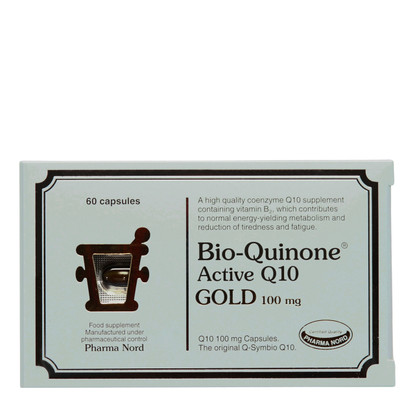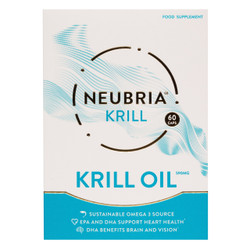Pharma Nord Bio-Quinone Q10 Gold features Q10 in the form of active ubiquinone and Vitamin B2 (riboflavin), which contribute to cellular energy metabolism and help reduce tiredness and fatigue.
Coenzyme Q10 (also called Q10) is a vitamin-like substance, also named ubiquinone (ubi is Latin and means ”everywhere”), which plays a vital role in the body's energy supply mechanism, acting alongside enzymes converting fats and sugars into energy. All body cells require a supply of Q10, with the heart and muscle cells having a particularly high demand.
Bio-Quinone Active Q10 GOLD consists of soft gelatin capsules with 100 mg of Q10 in the form of active ubiquinone dissolved in oil. Pharma Nord has spent more than 30 years on developing and optimising Bio-Quinone Q10 for the sole purpose of providing a Q10 preparation with scientific documentation for its superior bioavailability and quality. Riboflavin, also known as vitamin B2, has been added to contribute to cellular energy metabolism and to help reduce tiredness and fatigue.
Benefits of Pharma Nord's Bio-Quinone Q10 Gold:
- 100 mg of Q10 in the form of active ubiquinone per capsule
- Riboflavin (Vitamin B2) contributes to normal energy-yielding metabolism, to the protection of cells against oxidative stress, to the maintenance of normal red blood cells and to a normal metabolism of iron. Vitamin B2 also Helps to reduce tiredness and fatigue and helps to the maintenance of normal mucous membranes
- Manufactured to pharmaceutical standards
- Reference product for the International Coenzyme Q10 Association.
- Oil-based formulation for optimum absorption
Directions: As a food supplement, take one (1) to three (3) Bio-Quinone Q10 Gold capsules daily or as directed by a health professional.
Do not exceed the recommended daily dosage. To be taken preferably with or after a meal. Not suitable for vegetarians. Pregnant and lactating women and those on medication should seek professional advice prior to taking supplements. Nutritional supplements should not be used as a substitute for a varied diet and a healthy lifestyle. Store at room temperature out of direct sunlight. Keep out of reach of children.
Bulking agent: Soybean oil*, Capsule shell: Bovine Gelatine, Humectants: Glycerol, purified water, Co-enzyme Q10, Antioxidant: D-alpha-tocopherol, Colour: Iron oxide, Riboflavin, Vitamin: B2 (Riboflavin). *Does not contain phytoestrogens (estrogenic substances).
Is Q10 on the doping list?
The body produces Q10 on its own, and because there is Q10 in almost any diet, it is seemingly impossible to categorise supplementation with Q10 as doping. Q10 acts as a coenzyme (supporting enzyme) in the cells and thus also in the muscles' energy production mitochondria. We can produce some Q10 in the liver, and in addition we get minor amounts of Q10 from the diet. Many athletes do take supplements of Q10 to counteract declining Q10 levels, and the Q10 supplements are not categorised as doping.
Why can't I feel the effect of Q10?
Most people will experience an effect of Q10 supplementation, either directly or indirectly. Many so-called energy-based products get their effect from caffeine and caffeine-like substances from various plants that stimulate the adrenal glands to secrete stress hormones. Coenzyme q10, on the other hand, is present in all body cells and is part of the cells' natural way of producing energy. Thus, the biochemical processes in the body and the experience are not the same for these two different types of products. The fact that you may not feel an immediate effect of Q10 may also be due to one or more of the following factors:
- You are taking a Q10 product with low bioavailability
- You take your Q10 between meals and not together with fat
- You have reduced fat absorption from the gut
- You are so young that your Q10 level is still high
- You are taking medicines that reduce the body's own production of Q10 to a degree that requires a higher compensatory Q10 dosage
- You take Q10 for supper and will therefore only experience the maximum level in the blood at night while you are sleeping (it takes approx. 6 hours from ingestion until Q10 reaches its maximum level in the blood)
- You need more time. It can take a month or longer before the body's tissues are sufficiently saturated with Q10
- You need a higher dose
What kind of Q10 is best absorbed?
To date, more than 40 scientific studies have been published, showing that, once it has been absorbed, the ubiquinone form of Q10 has relatively good bioavailability and efficacy. However, not much evidence has been published on the bioavailability and efficacy of QH (ubiquinol). Various Q10 products are available either as tablets or as capsules. The Q10 content may be in the form of crystals or granules, encapsulated in liposomes, in micelles attached to nanoparticles, or dissolved in oil.
What are the best dietary sources of Q10?
Cereal products usually contain coenzyme Q9, whereas soybeans do contain some coenzyme Q10. There is also some Q10 in walnuts, almonds, oil-rich fruits, and green vegetables, especially spinach. Furthermore, fish contains Q10, especially sardines, which contain twice as much Q10 as beef. Even so, one would have to eat one pound of sardines, two pounds of beef, or 2.5 pounds of peanuts in order to get 30 mg of Q10. Typically, there is somewhere between 5 and 10 mg of Q10 in the food we eat on a daily basis. Most individuals probably get around 5 mg a day.
How do I optimise the body's own production of coenzyme Q10?
It is possible to increase the body's own production of coenzyme Q10 by exercising and by optimising the intake of nutrients. The cell's production of Q10 is a complex process involving many biochemical steps. In order for the body to produce coQ10, there is a need for a vitamin B complex, vitamins C and E, selenium, magnesium, and several trace elements. A lack of one or more of these nutrients will affect the body's Q10 production considerably. An increase in available Q10 in the body will usually be larger with the aid of even a small daily supplement of Q10.
Ubiquinone CoQ10 or Ubiquinol CoQ10?
Q10 is best known for its oxidised form, ubiquinone, introduced in Europe shortly after 1990. Globally, ubiquinone has also been the only form of Q10 whose effect has been documented in scientific studies. Ubiquinol, the reduced form of Q10, was first brought to market in 2006. Since then, ubiquinol has been marketed as active Q10, although it's no more active than ubiquinone. Almost all documentation on the prevention and treatment of Q10 deficiency states has been performed with ubiquinone. At the molecular level, ubiquinol has two extra hydrogen molecules and forms, in conjunction with oxygen, a so-called hydroxyl group on the head of the Q10 molecule, which is a quinone ring.
The two forms of Q10, however, have quite different roles in the body. Ubiquinol donates electrons, whereas ubiquinone receives electrons. Ubiquinol performs an important function as an antioxidant in the body, but in the cells' energy-producing mitochondria, the two forms constantly switch from the one form to the other—that is, from the oxidised to the reduced and back again. Thus, one cannot say that one form of Q10 is more active or more important than the other. Appearance differences can be seen below; it is therefore easy to test whether the product you buy is normal or reduced Q10. The Q10 that we produce in the body's cells is oxidised Q10, whereas 90-95% of Q10 circulating in the blood is in the form of reduced Q10.
How long can I take Q10?
Q10 is generally considered a safe substance. Long-term studies of more than 5 years, as well as studies with daily doses, have shown that it is safe to take supplements of Q10 for a long period. After discontinuation of supplementation, the body's Q10 level will return to the same level as before the start of supplementation. This shows that Q10 supplementation does not affect the body's own production of the substance.
When is the best time of day to take CoQ10?
Since Q10 is fat-soluble substance, it is important to take it with a meal that contains some fat. The effect is observed after a short-term use and is felt most acutely approx. 6 hours after ingestion. Therefore, Q10 should most effectively be taken with breakfast, perhaps lunch. If you take more than 1 capsule of ubiquinone per day, the absorbability will be greater if you spread the dose throughout the day, i.e. 1 capsule at breakfast and 1 capsule at lunch time. Furthermore, you can take a supplement of the amino acid carnitine, which interacts closely with Q10 in the cells' mitochondria. Carnitine helps with the transport of fatty acids into the mitochondria, and Q10 is involved in the oxidation process that converts these fatty acids into energy in the form of ATP.
How can I avoid eating the gelatin in the Q10 capsules?
You can cut a small hole in the soft gel capsules with a pair of scissors and squeeze the content of the capsule out in a spoon or directly into your mouth. However, a small residue of Q10 will remain on the inside of the capsule using this method.
Will taking Q10 before bed interrupt my sleep?
Generally not, but in a few instances people have experienced broken sleep after taking Q10 in the evening. If you should experience this, it is recommended to take your Q10 at breakfast or lunch.
Should I take my Q10 capsules all together or should I split the dose?
Ideally, leaving around 3 hours between each capsule can help improve the absorption.
Food supplements should not be used as a substitute for a varied diet. Store in a cool, dry place away from direct sunlight. Keep out of reach of young children. Do not exceed the daily dose. If pregnant, or breastfeeding, or if you are taking medication, or on medical care, consult your physician prior to use. While we work to ensure that product information on our website is correct, on occasion manufacturers may alter their ingredient lists. Actual product packaging and materials may contain more and/or different information than that shown on our website. All information about the products on our website is provided for information purposes only. We recommend that you do not solely rely on the information presented on our website. Please always read the labels, warnings, and directions provided with the product before using or consuming a product. In the event of any safety concerns or for any other information about a product please carefully read any instructions provided on the label or packaging and contact the manufacturer. Content on this site is not intended to substitute for advice given by medical practitioner, pharmacist, or other licensed health-care professional. Contact your health-care provider immediately if you suspect that you have a medical problem. Information and statements about products are not intended to be used to diagnose, treat, cure, or prevent any disease or health condition. The customer reviews are only moderated for offensive content – they should not be regarded as medical or health advice; no reliance should therefore be placed on them; and they are not endorsed by Victoria Health. If you have any health problems or questions regarding the suitability of any product please contact a health professional. Products are not medicinal unless otherwise stated. Victoria Health accepts no liability for inaccuracies or misstatements about products by manufacturers or other third parties. This does not affect your statutory rights.







